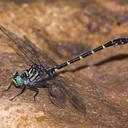United States and Canada
This species is the smallest clubtail in the region and is found in forest streams in eastern Oklahoma and western Arkansas. The body is dark green with distinct black cross stripes on the face. The thorax is green with the front appearing black except for a thin pale middorsal carinae, two lateral pale stripes and the anterior collar. The humeral and midlateral stripes are all dark and well-developed. The third lateral stripe is usually present, but may be lacking in some individuals. The wings are clear with a dark brown pterostigma and sometimes a hint of flavescence basally. The abdomen is black, with a narrow pale yellowish-green basal rings. The caudal appendages are pale distally.
Size: Total length: 31-36 mm; abdomen: 21-26 mm; hindwing: 20-23 mm.
Similar Species (south-central US): All other clubtails in our region are much larger
Habitat: Shallow forest streams with moderate current.
Natural History: The larva of this species is much easier found than the wary adults. Males will perch on emergent rocks and gravel bars in the sun, surrounded by swift current and are quick to rapid flight if disturbed. Least Clubtail has been described as "wary and nervous, their flight impossible to follow." Females lay eggs in the afternoon by flying low to the water in a figure eight or similar pattern, tapping their abdomen and releasing eggs in areas of moderate riffle. One study found Least Clubtail larvae had a significant preference for the interstitial spaces at the edge of riffles in Ozark streams. This species was only recently described, splitting it from Stylogomphus albistylus (Cook and Lau dermilk 2004).
Distribution: Kentucky and Tennesse, west to eastern Oklahoma
Source: Abbott, J.C. 2006-2010. OdonataCentral: An online resource for the distribution and identification of Odonata. Available at OdonataCentral.
Edited by Drew Weber (9/24/2015).
